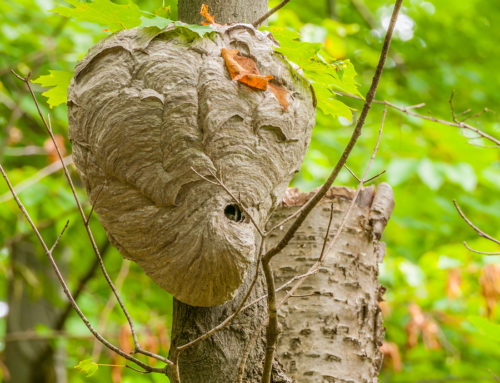Some of the worst pests only show their faces in the summer, like mosquitoes. But fall is still a prime time for pests-and some pests even become more aggressive at the end of summer and into fall, such as yellow jackets.
This fall, don’t forget to continue protecting your property from this pesky nuisance.
How Do Yellow Jackets Differ From Other Stinging Pests?
Some homeowners make the mistake of assuming any yellow-and-black-striped, flying, stinging insects are bees. But bees and yellow jackets are actually quite different. Honeybees and bumblebees are generally easygoing. If you stay out of their way, they’ll do their best to stay out of your way. Plus, bees are helpful pollinators who make your garden look beautiful.
Most homeowners only need to remove bees if someone in their family is allergic, if bees start to swarm, or if the bees are property-damaging bees, such as carpenter bees. A pest control company or beekeeper can safely remove bees instead of killing them.
However, yellow jackets are a type of wasp, which means they have yellow and black stripes, but they aren’t fuzzy, and they have thinner abdomens than bees. Because wasps aren’t fuzzy, they aren’t as effective pollinators as bees, which have hair that picks up pollen.
Many wasps build paper nests high up in trees, but yellow jackets build their nests in the ground-which can make them a frightening surprise for homeowners trying to mow the lawn. In particular, yellow jackets often burrow in abandoned rodent nests, so one way to keep yellow jackets out of your yard is to eliminate moles and mice at the start of spring.
Yellow jackets are carnivorous, so they can inadvertently act an effective pest control method by eating insects like caterpillars that damage your garden. But yellow jackets eat much more than bugs, as you know if you’ve ever hosted a picnic in your backyard. They’re drawn to meat and sugar, and their help with insect control isn’t worth enduring their aggressive nature and the potential for stings.
Why Are Yellow Jackets Dangerous in the Fall?
Most honeybees die soon after they sting, so they do so only when they feel you’re threatening their colony. Plus, only female honeybees have stingers. Their stings can hurt more than yellow jacket stings because the stinger continues to push venom into your skin up to 10 minutes after the sting itself, so you should remove a bee’s stinger from your skin as soon as possible.
In contrast, yellow jackets can sting you over and over again without experiencing any harm to themselves. Anything that causes the ground to vibrate, like the sound of your footsteps, a hedge trimmer, or lawn mower, can make them feel threatened enough to sting.
Yellow jackets are much more likely to attack and sting than honeybees, and their sting marks you with a chemical that encourages other yellow jackets to attack. Once one yellow jacket attacks you, the others can flood out of the ground and join in.
Attacks are particularly dangerous in the fall: if the summer drags on without you finding and removing their nest, the colony can have hundreds or even thousands of individual yellow jackets by August or September.
As the fall drags on, yellow jackets also lose most of their main food sources. Morning frosts and cold nights kill off garden pests, which eventually kills off the yellow jackets as well. In the meantime, though, they can harass you more than usual when you appear outside with food and increase your risk of getting stung.
What Can You Do About Yellow Jacket Infestations?
Trying to remove yellow jackets on your own is dangerous. It’s best to entrust the job to a professional. While you wait for a professional, you can hang up a yellow jacket trap in your backyard. If you only see a few yellow jackets, you can try using a spray, but it’s best to try the spray at night. The yellow jackets will move slower in the cold fall night air.
If you truly want to try to remove the yellow jacket nest yourself, make sure you wear the same protective gear a beekeeper would wear, including long sleeves, long pants, protective gloves, sturdy boots, and a hat with a net. Again, though, if you want to stay safe, you should call a professional pest removal company.
What If You Get Attacked?
If a yellow jacket flies near you, try not to slap at it or run away-both of those actions can provoke the yellow jacket and make it more likely to sting. Instead, walk away calmly.
If you do get stung, get away from the area as quickly as possible so you can avoid being attacked by a swarm. Walk, not run, quickly but calmly away from the area in a straight line. If you get stung multiple times, especially if you get stung on the throat, you should visit a doctor immediately. And, of course, if you’re allergic to bees and wasps, use an EpiPen and go to the emergency room at your nearest hospital.
If you only get stung a few times and aren’t allergic to bees, you can put an ice pack covered in a towel on the site to reduce swelling. An antihistamine might help you control the allergic reaction, and a pain reliever like ibuprofen can control the pain. You can also try applying a mixture of water and baking soda to your skin.
Call a Pest Control Company Today
Even though the summer heat is gone, yellow jackets can still harass you, your family members, and your guests. Control this pest by calling Cavanaugh’s for effective, thorough, and safe pest extermination services.


